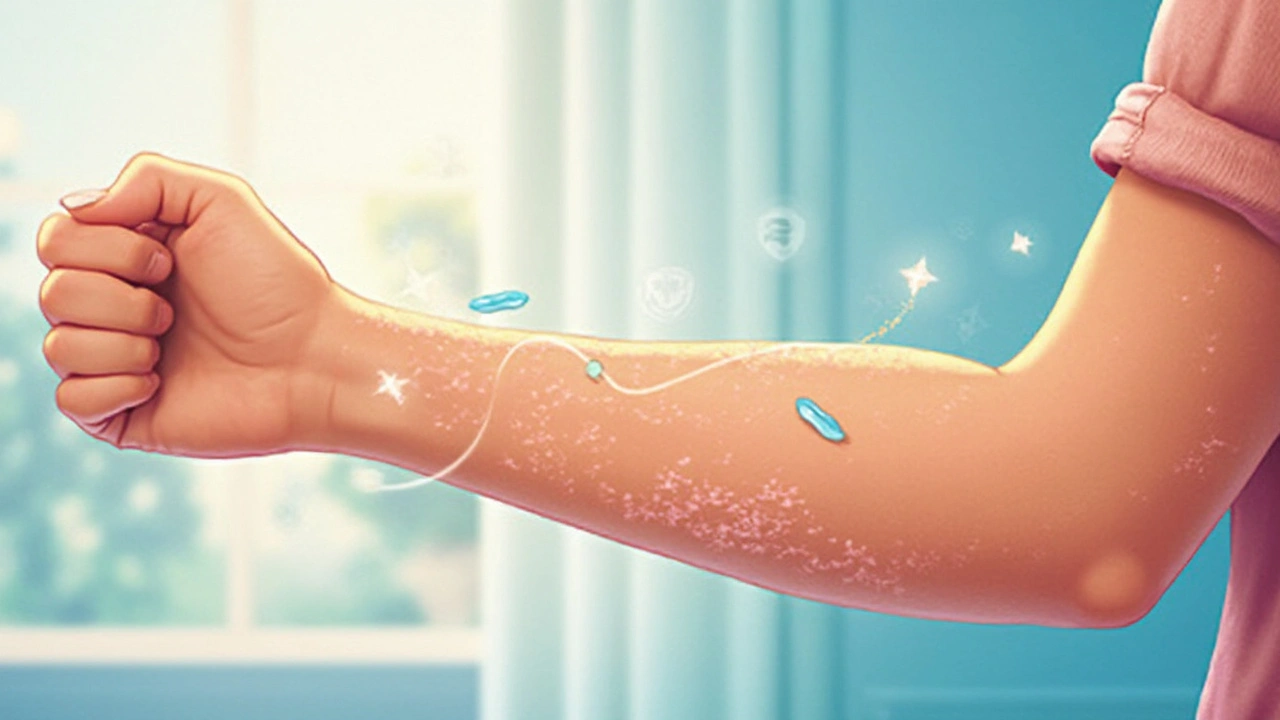Let’s be real. Cuts, scrapes, or that angry spot that showed up after shaving—almost everyone runs into minor skin troubles. You slap on a regular ointment, cross your fingers, and hope for the best, right? Sometimes that works, but sometimes, things get uglier: the redness grows, pus shows up, or it just won’t heal. This is where Bactroban Ointment 5g steps into the spotlight. It’s tiny, but mighty—it packs a punch against some pretty pesky skin infections that don’t back down to your standard creams.
What Exactly is Bactroban Ointment 5g?
Bactroban is the brand name for mupirocin, a topical antibiotic cream doctors have in their arsenal for fighting skin infections. Developed in the late 1980s, Bactroban quickly became a go-to choice for things like impetigo (that crusty rash kids sometimes get), infected cuts, or even stubborn staph noses. The 5g tube is a common size, perfect for stashing in your bathroom cabinet or travel bag.
Mupirocin works by messing with bacteria’s ability to make proteins. Without proteins, bacteria can’t grow or multiply. Unlike many antibiotics you swallow (which work all over the body), Bactroban is for skin-only use. It’s strong against certain bacteria, especially Staphylococcus aureus and Streptococcus pyogenes, which are some of the top culprits behind skin infections. A study published in the "Journal of Clinical Dermatology" found mupirocin wiped out 97% of staph bacteria in mild-to-moderate skin infections within just five days.
You’ll often spot it prescribed for:
- Impetigo (think honey-colored scabs, mostly on kids' faces and arms)
- Secondarily infected eczema (that’s eczema that got an extra, unwanted bacterial guest)
- Infected minor cuts, scrapes, and wounds
- Folliculitis (those small, sometimes itchy bumps around hair follicles)
- In the nose for eradicating staph carriers to prevent spread, known as MRSA decolonization
And here’s an interesting bit: hospitals often use it before certain surgeries for patients at risk of Staph infections. So if your doctor hands you a prescription, you’re in good company.
Bactroban ointment comes in a small, easy-to-squeeze aluminum tube. You only need a thin layer—more isn’t better, it’s just waste.
How to Use Bactroban Ointment 5g for Best Results
First things first: always listen to your doctor. They might have special instructions for you. But if you’re looking for the best general approach, these tips can make all the difference:
- Wash your hands before and after using—it’s not a step to skip. Clean hands prevent spreading more bacteria to the area.
- If your wound is dirty, gently clean it with mild soap and water. Pat dry with a clean towel—not the kitchen dishcloth, please.
- Use a cotton swab or your fingertip to apply a thin layer of ointment. Don’t slather it—just enough to cover the infected spot.
- You can cover it with a bandage, but it’s not always necessary unless your doctor says so or it’s likely to rub off on your clothes.
- Repeat this process up to three times a day, usually for 5 to 10 days. Most people see improvements within three to five days if it’s working. Even if it looks better, stick with the course—cutting it short can let the infection come back stronger.
If you’re using it inside your nose, a tiny blob (about the size of a match head) for each nostril is all you need. Gently press the sides of your nose to spread it around. This is called intranasal decolonization and is often used for those who carry MRSA bacteria.
Don’t use Bactroban on burns, huge wounds, or animal bites unless your doctor gives you the go-ahead. Never eat it or put it in your eyes—if you do, rinse thoroughly and get medical help fast.
A pro tip: finish the tube within 10 days of opening if possible, and toss any leftovers—you don’t want resistant bacteria hanging around your medicine drawer.

What Side Effects or Problems Should You Watch For?
Most people breeze through Bactroban without a hitch, but side effects happen. You could feel a mild stinging or burning sensation when you first apply it. That usually settles in a minute or two. Redness, itching, or dryness are less common, but if your skin starts looking worse or you see blisters, stop right away. Rarely, allergic reactions pop up—think rash, swelling, or trouble breathing. If that hits you, drop everything and get medical attention.
Overuse or using it for weeks on end isn’t smart. The reason? Bacteria are sneaky—they evolve. If they start ignoring mupirocin, it may stop working when you really need it. According to a study in "The Lancet Infectious Diseases," misuse is what’s driving the rare—but real—rise in resistant bacteria. So, only use Bactroban for what your doctor says, and don’t pass it around the family.
Some folks wonder if you can use Bactroban for acne. It might help if there’s an obvious infection, but it's not designed for everyday pimples. There are better options for regular acne. If your breakout seems infected (red, swollen, sore), see your doctor first before grabbing antibiotic creams willy-nilly.
Applying to big areas, broken skin, or using inside the mouth can increase the risk of it soaking in and causing side effects. Stick to instructions—it’s not a "more is more" kind of product. If you accidentally use too much, just wipe it off and carry on.
If you’re pregnant or breastfeeding, tell your doctor. Although skin absorption is minimal, it’s smart to play it safe. The clinical consensus is mupirocin isn’t harmful in these cases, but always double-check before use.
| Possible Side Effect | How Common? |
|---|---|
| Mild burning/stinging | Common |
| Redness or itching | Sometimes |
| Allergic rash | Rare |
| Blistering or swelling | Very Rare |
"As with any topical antibiotic, mupirocin should be used precisely as prescribed to reduce the risk of resistance and preserve its effectiveness." — Dr. Amy Ghadiali, American Academy of Dermatology.
Expert Tips and Lesser-Known Facts About Bactroban Ointment
You might think all ointments are created equal, but Bactroban holds a special place in the first-aid world. Here are a few reasons why:
- Bactroban (mupirocin) is unique because it doesn’t cross-react with most other antibiotics. If you’re allergic to penicillin, you can usually use Bactroban safely.
- Research shows mupirocin works even against strains of MRSA (methicillin-resistant Staph aureus), making it a key weapon in hospitals and for people at higher risk of serious skin infections.
- If you’re using it for impetigo, it’s actually faster at clearing the rash than some oral antibiotics, with fewer side effects like tummy upset.
- It’s safe for most kids over 2 months old, which isn’t true for a lot of strong antibiotics.
- Don’t forget to check the expiration date—expired ointment can lose effectiveness and harbor bacteria.
- Never use Bactroban for fungal infections or viral infections like cold sores or warts—it simply won’t work.
- Avoid mixing with other creams or lotions on the same area. This can dilute the antibiotic or cause irritation.
Some folks swear by keeping a 5g tube in their camping, hiking, or sports bag just in case. The tube is tiny and light, but in those environments, an infected scrape can turn serious fast. For athletes and gym-goers, it’s a secret weapon against the spread of staph or "mat rash" in high-contact sports.
If you’re prone to recurring skin infections or have family members who catch them regularly, ask your doctor about ways to reduce the risk—including good hygiene, not sharing towels or razors, and a possible short course of Bactroban for known staph carriers in the household. “Decolonization” can knock out hidden bacteria before they start trouble.
For adults and teens, if you’re prescribed Bactroban for a visible infection and don’t see improvement in three to five days, call your doctor. Don’t keep trying random ointments or old prescriptions—it could make things worse.
One last fun fact: mupirocin was discovered from a type of bacteria found in soil on the north coast of England. Who knew healing could start from a patch of dirt?
So the next time a minor wound gets ugly, or your doctor mentions bacterial skin infections, you’ll know why this little tube gets a lot of respect. Used the right way, Bactroban Ointment 5g often means the difference between quick healing and weeks of bigger problems. Give your medicine cabinet a check—having it on hand can save you a trip later.







sharicka holloway June 26, 2025
I keep a tube of this in my first-aid kit after my kid got impetigo last year. It worked faster than anything else and didn't make him cranky like oral antibiotics did. No drama, just results.
Lauren Zableckis June 26, 2025
I used to think antibiotic creams were overkill for small cuts until I got a stubborn staph infection after a tattoo. Bactroban cleared it in four days. I don't use it lightly anymore, but I'm glad it exists.
reshmi mahi June 28, 2025
USA makes everything into a miracle drug lol. We have better natural remedies in India like turmeric paste and neem oil. This is just fancy chemical marketing.
laura lauraa June 29, 2025
I find it profoundly concerning that we have normalized the casual use of topical antibiotics as if they were moisturizers. The normalization of pharmaceutical dependency is a symptom of a deeper cultural decay. We are not treating infections-we are surrendering to microbial hegemony.
Gayle Jenkins June 30, 2025
If you're using this for folliculitis or a shaving rash, don't just slap it on and forget it. Clean the area with alcohol wipes first, then apply a thin layer. It makes a huge difference. And don't share your tube-seriously, that's how you spread MRSA.
Kaleigh Scroger July 1, 2025
I'm a nurse and I've seen this work miracles on infected wounds in elderly patients who can't tolerate oral meds. The key is consistency and not overusing it. I always tell my patients to use it like a paintbrush not a paint roller. And never use it past the expiration date. Expired mupirocin is basically useless and could be a breeding ground for worse bugs
Elizabeth Choi July 2, 2025
The 97% efficacy stat is misleading. That was in a controlled trial with clean wounds. In real life, people use it on dirty cuts, don't finish the course, and then wonder why it doesn't work. Also, the study was funded by GlaxoSmithKline.
Allison Turner July 3, 2025
Why do people even need this? Just clean it with soap and water. If it doesn't heal, go to the doctor. Stop treating every pimple like it's the plague.
Darrel Smith July 5, 2025
This stuff is dangerous. The government lets you buy it over the counter in some places. What if someone uses it for a cold sore? Then they get resistant bacteria. And then what? We're one bad decision away from a superbug apocalypse. People are lazy and they think medicine is magic.
Aishwarya Sivaraj July 6, 2025
I live in a village in India and we use neem and honey for cuts but i tried bactroban when my niece got infected after a fall and wow it worked fast. But dont use it every time. Only when its really bad. And always wash hands first
Iives Perl July 7, 2025
This is a government mind control tool. They want us dependent on antibiotics so they can track us through our prescriptions. Also, the 5g tube? Too small. They want you to buy more. 🤫
steve stofelano, jr. July 7, 2025
It is with considerable respect that I acknowledge the clinical efficacy of mupirocin as delineated in the aforementioned text. The precision of its mechanism of action, particularly vis-à-vis bacterial protein synthesis inhibition, represents a triumph of pharmaceutical science. One must, however, exercise due diligence in its application, as the integrity of antimicrobial stewardship remains paramount.
Savakrit Singh July 8, 2025
In India, we have 10x better alternatives. This is just overpriced western nonsense. Also, why is it so expensive? 🤡
Cecily Bogsprocket July 8, 2025
I used to be skeptical too, until my dog scratched my leg and it turned into this red, angry mess. I didn't want to go to the doctor, so I tried Bactroban. It didn't fix it overnight, but it stopped it from getting worse. By day three, I could see the redness pulling back. It felt like the infection was just... giving up. I still keep a tube in my drawer. Not because I'm scared, but because I know what it can do when you need it.
Jebari Lewis July 10, 2025
I’ve been using this for years after gym workouts. The mats are gross. One time I got a bad folliculitis flare-up after leg day. I applied it twice a day, kept the area clean, and within five days it was gone. I tell all my workout buddies to keep a tube in their locker. Prevention > cure. Also, wash your towels. Seriously. You’re sharing bacteria like it’s a group project.
Emma louise July 10, 2025
Oh great, another American miracle cure. In my country, we just use salt water and patience. This is just corporate greed wrapped in a tiny tube.
sharicka holloway July 10, 2025
I'm glad you mentioned the nose application. My son was a MRSA carrier and the doctor had us do intranasal treatment for 5 days. It felt weird, but it worked. We haven't had a recurrence in two years. It's not glamorous, but it's life-changing.